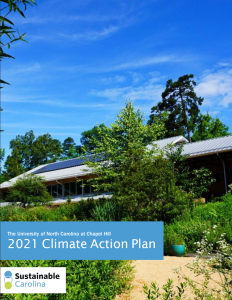Part of the Plan
Sustainable Carolina announced a new Climate Action Plan (CAP) in April 2021, renewing the University’s commitment to sustainability progress through concerted actions. The CAP established specific, achievable and substantive goals and strategies for reducing emissions while creating an open environment for community collaboration through a stakeholder engagement process.
Throughout the 2020-2021 academic year, limitations on in-person gatherings spurred on by the global COVID-19 pandemic complicated traditional methods of stakeholder engagement – through large, in-person meetings. To navigate this, Sustainable Carolina modified stakeholder engagement around the CAP to include a form-based virtual feedback approach and extended feedback collection window, increasing inclusivity and amplifying the voices of individuals.
The 2021 CAP is a living document that focuses on two key emissions goals:
- Complying with Governor Roy Cooper’s Executive Order 80 which calls for a 40% statewide reduction of greenhouse gas (GHG) emissions by 2025.
- Achieving net-zero GHG emissions by 2040 instead of the original target of 2050.
Carolina’s 2021 CAP is live on the Sustainable Carolina site and provides specific strategies, such as eliminating coal use, increasing efficiency, and procuring renewable energy through multiple sources. Progress on these strategies are evaluated through updates and analyses such as the annual campus greenhouse gas inventory and the GHG by the Numbers factsheet.
 By the Numbers
By the Numbers
In addition to tracking progress on the CAP, the annual campus GHG inventory measures progress on UNC’s commitment to climate neutrality, which was signed originally in 2007 and amended in 2021 to move the neutrality target up to 2040 from 2050.
UNC-Chapel Hill conducted its first GHG inventory in 2007, establishing that year as a baseline for annual campus GHG reporting. The latest inventory for 2020 is in final review but already shows that overall emissions have fallen 40% since 2007.
About the GHG inventory, Sustainable Carolina’s Sustainability Analyst Melanie Elliott, said, “It’s always great to analyze the GHG inventory, but this year was especially exciting because 2020 was the first full year that the Cogen burner restoration project was complete. The completion of the project means that the University has significantly reduced its reliance on coal.” The 2020 GHG inventory also provides insights into the impacts of pandemic-related operational changes on campus emissions.
“It’s always great to analyze the GHG inventory, but this year was especially exciting because 2020 was the first full year that the Cogen burner restoration project was complete. The completion of the project means that the University has significantly reduced its reliance on coal.” – Melanie Elliott, Sustainability Analyst
Transportation-related (commuting and air travel) sources were confirmed to be the most affected by the pandemic. Steam production remained relatively constant due to high demand from UNC Hospitals, but stationary combustion emissions still fell by almost 14% between 2019 and 2020 due to reduced coal use. From the 2007 baseline, coal use at UNC has decreased by 52% and continues to be phased out. Additional highlights of GHG progress can be seen in the GHG by the Numbers factsheet.

